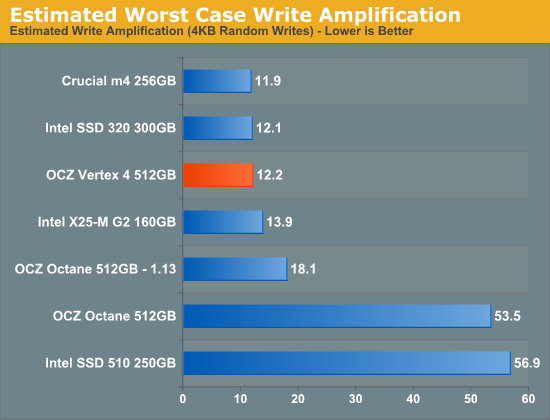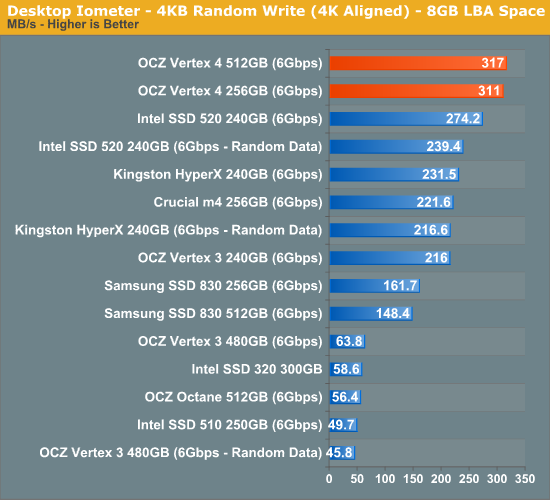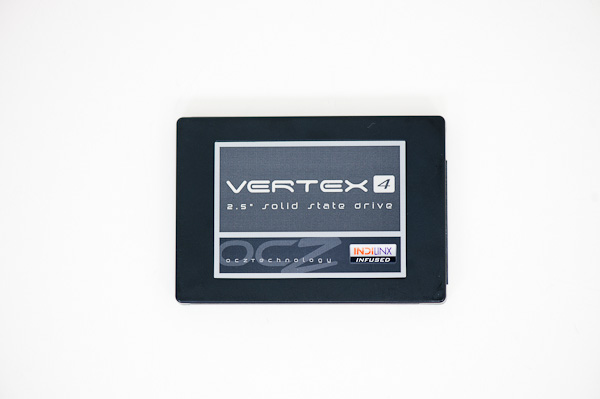OCZ Vertex 4 Review (256GB, 512GB)
by Anand Lal Shimpi on April 4, 2012 9:00 AM ESTThirteen months ago OCZ announced its intention to acquire Indilinx, the SSD controller maker that gave Intel its first taste of competition in the consumer market in 2009. Eight months later, OCZ launched its first post-acquisition SSD based on Indilinx silicon. Today, just five months after the launch of the Octane, OCZ is officially releasing the Vertex 4 – based on its Indilinx Everest 2 silicon. In less than a year, OCZ has brought to market more Indilinx powered controllers than Indilinx did in the previous three years. It's rare that you see the fruits of acquisition so quickly, but if there's anything OCZ's CEO Ryan Petersen is good at it's pushing for an aggressive schedule.
Rather than call this drive the Octane 2, OCZ went with Vertex 4, indicating its rightful place at the top of OCZ's SSD lineup. The implications run even deeper. It marks the first time in two years that a Vertex drive will ship without a SandForce controller inside. Make no mistake, while Octane was a shot across SandForce's bow, Vertex 4 means war. While OCZ continues to ship tons of SandForce controllers, the future for the company is Indilinx. The Vertex 4 is just the beginning. OCZ will continue to ship Vertex 3 in parallel, and should a future SandForce controller make competitive sense to use OCZ will definitely consider it, but the intention is to build the fastest silicon internally and use it as much as possible.
The dramatic departure in naming also embodies just how different Everest 2 is from the original Everest controller. OCZ claims there's minimal shared code between the Octane and Vertex 4 firmware, and the two drives perform very differently. Write amplification was always a concern with the Octane - it is no longer a major issue with the Vertex 4. OCZ and its Indilinx team have reduced write amplification to roughly the levels of Intel's controllers:

Indeed write performance is improved significantly as a result. A look at the spec sheet gives us the first indication of what's to come:
| OCZ SSD Comparison | ||||||
| OCZ Vertex 4 | OCZ Vertex 3 | OCZ Octane | OCZ Vertex 2 | |||
| Current NAND | 25nm IMFT MLC | 25nm IMFT MLC | 25nm IMFT MLC | 25nm IMFT MLC | ||
| Capacities | 128, 256, 512GB | 60, 90, 120, 240, 480GB | 128, 256, 512GB, 1TB | 60, 120, 240GB | ||
| Controller | Indilinx Everest 2 | SF-2281 | Indilinx Everest | SF-1221 | ||
| Max Seq Read | 535 MB/s | 550 MB/s | 480 MB/s | 285 MB/s | ||
| Max Seq Write | 475 MB/s | 500 MB/s | 330 MB/s | 275 MB/s | ||
| Max Random Read | 95K IOPS | 60K IOPS | 26K IOPS | - | ||
| Max Random Write | 85K IOPS | 85K IOPS | 35K IOPS | 50K IOPS | ||
| AES-256 Encryption | Yes | Yes | Yes | No | ||
Regardless of the nature of the data (compressible or incompressible), the Everest 2 powered Vertex 4 promises better random write performance than any other consumer SSD on the market today. And it delivers:

Random write speed is nothing short of incredible. OCZ is able to equal SandForce's write speed on highly compressible data without resorting to any sort of data compression. This is a purely algorithmic advantage. While the original Everest was a work in progress by the time OCZ acquired the company, Everest 2 is the first Indilinx project OCZ had complete control over. Apparently OCZ's CEO, Ryan Petersen had a lot of his own input built into this design.
| OCZ Vertex 4 Lineup | |||||
| 512GB | 256GB | 128GB | |||
| NAND Configuration | 16 x 32GB 25nm Intel sync NAND | 16 x 16GB 25nm Intel sync NAND | 8 x 16GB 25nm Intel sync NAND | ||
| DRAM | 2 x 512MB DDR3-800 | 2 x 512MB DDR3-800* |
2 x 512MB DDR3-800* | ||
| Controller | Indilinx Everest 2 | Indilinx Everest 2 | Indilinx Everest 2 | ||
| Max Seq Read | 535 MB/s | 535 MB/s | 535 MB/s | ||
| Max Seq Write | 475 MB/s | 380 MB/s | 200 MB/s | ||
| Max Random Read | 95K IOPS | 90K IOPS | 90K IOPS | ||
| Max Random Write | 85K IOPS | 85K IOPS | 85K IOPS | ||
| MSRP | $699 | $349 | $179 | ||
The Vertex 4 will be available in three capacities initially – 128GB, 256GB and 512GB, with a 1TB version following. Drives should be available today but in very limited quantities, and likely only 128GB capacities at the start. MSRP is fairly competitive with other 6Gbps drives on the market today:
| SSD Pricing Comparison | |||||
| 128GB | 256GB | 512GB | |||
| Crucial m4 | $154.99 | $299.99 | $549.99 | ||
| Intel SSD 520 | $184.99 | $344.99 | $799.99 | ||
| Samsung SSD 830 | $174.99 | $299.99 | $779.99 | ||
| OCZ Octane | $199.99 | $339.99 | $849.99 | ||
| OCZ Vertex 3 | $199.99 | $339.99 | $1199.99 | ||
| OCZ Vertex 4 | $179 MSRP | $349 MSRP | $699 MSRP | ||











127 Comments
View All Comments
Kristian Vättö - Wednesday, April 4, 2012 - link
240GB Vertex 3 is actually faster than 480GB Vertex 3:http://www.anandtech.com/bench/Product/352?vs=561
http://www.ocztechnology.com/res/manuals/OCZ_Verte...
MarkLuvsCS - Wednesday, April 4, 2012 - link
256gb and 512gb should perform nearly identical because they have the same number of NAND packages - 16. the 512gb version just uses 32gb vs 16gb NAND in the 256gb version. The differences between the 256 and 512 gb drives are negligible.Iketh - Wednesday, April 4, 2012 - link
that concept of yours depends entirely on how each line of SSD is architected... it goes without saying that each manufacturer implements different architectures....your comment is what is misleading
Glock24 - Wednesday, April 4, 2012 - link
"...a single TRIM pass is able to restore performance to new"I've seen statements similar to this on previous reviews, but how do you force a TRIM pass? Do you use a third party application? Is there a console command?
Kristian Vättö - Wednesday, April 4, 2012 - link
Just format the drive using Windows' Disk Management :-)Glock24 - Wednesday, April 4, 2012 - link
Well, I will ask this another way:Is there a way to force the TRIM command that wil nor destroy the data in the drive?
Kristian Vättö - Wednesday, April 4, 2012 - link
If you've had TRIM enabled throughout the life of the drive, then there is no need to TRIM it as the empty space should already be TRIM'ed.One way of forcing it would be to multiply a big file (e.g. an archive or movie file) until the drive runs out of space. Then delete the multiples.
PartEleven - Wednesday, April 4, 2012 - link
I was also curious about this, and hope you can clarify some more. So my understanding is that Windows 7 has TRIM enabled by default if you have an SSD right? So are you saying that if you have TRIM enable throughout the life of the drive, Windows should automagically TRIM the empty space regularly?adamantinepiggy - Wednesday, April 4, 2012 - link
http://ssd.windows98.co.uk/downloads/ssdtool.exeThis tool will initiate a trim manually. Problem is that unless you can monitor the SSD, you won't know it has actually done anything. I know it works with Crucial Drives on Win7 as I can see the SSD's initiate a trim from the monitoring port of the SSD when I use this app. I can only "assume" it works on other SSD's too but since I can't monitor them, I can't know for sure.
Glock24 - Wednesday, April 4, 2012 - link
I'll try that tool.For those using Linux, I've used a tool bundled with hdparm calles wiper.sh:
wiper.sh: Linux SATA SSD TRIM utility, version 3.4, by Mark Lord.
Linux tune-up (TRIM) utility for SATA SSDs
Usage: /usr/sbin/wiper.sh [--max-ranges <num>] [--verbose] [--commit] <mount_point|block_device>
Eg: /usr/sbin/wiper.sh /dev/sda1